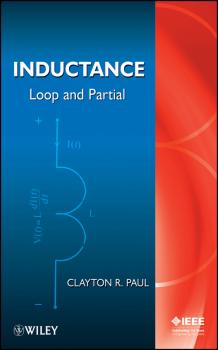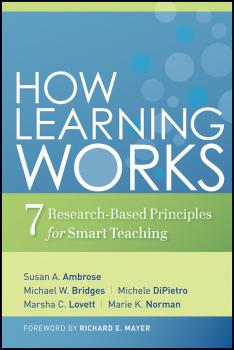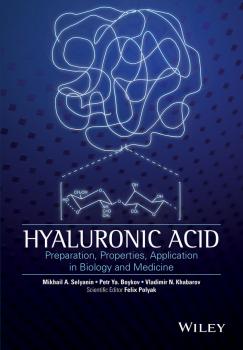Прочая образовательная литература
Различные книги в жанре Прочая образовательная литератураInductance. Loop and Partial
The only resource devoted Solely to Inductance Inductance is an unprecedented text, thoroughly discussing «loop» inductance as well as the increasingly important «partial» inductance. These concepts and their proper calculation are crucial in designing modern high-speed digital systems. World-renowned leader in electromagnetics Clayton Paul provides the knowledge and tools necessary to understand and calculate inductance. Unlike other texts, Inductance provides all the details about the derivations of the inductances of various inductors, as well as: Fills the need for practical knowledge of partial inductance, which is essential to the prediction of power rail collapse and ground bounce problems in high-speed digital systems Provides a needed refresher on the topics of magnetic fields Addresses a missing link: the calculation of the values of the various physical constructions of inductors—both intentional inductors and unintentional inductors—from basic electromagnetic principles and laws Features the detailed derivation of the loop and partial inductances of numerous configurations of current-carrying conductors With the present and increasing emphasis on high-speed digital systems and high-frequency analog systems, it is imperative that system designers develop an intimate understanding of the concepts and methods in this book. Inductance is a much-needed textbook designed for senior and graduate-level engineering students, as well as a hands-on guide for working engineers and professionals engaged in the design of high-speed digital and high-frequency analog systems.
How Learning Works. Seven Research-Based Principles for Smart Teaching
Praise for How Learning Works «How Learning Works is the perfect title for this excellent book. Drawing upon new research in psychology, education, and cognitive science, the authors have demystified a complex topic into clear explanations of seven powerful learning principles. Full of great ideas and practical suggestions, all based on solid research evidence, this book is essential reading for instructors at all levels who wish to improve their students' learning.» —Barbara Gross Davis, assistant vice chancellor for educational development, University of California, Berkeley, and author, Tools for Teaching «This book is a must-read for every instructor, new or experienced. Although I have been teaching for almost thirty years, as I read this book I found myself resonating with many of its ideas, and I discovered new ways of thinking about teaching.» —Eugenia T. Paulus, professor of chemistry, North Hennepin Community College, and 2008 U.S. Community Colleges Professor of the Year from The Carnegie Foundation for the Advancement of Teaching and the Council for Advancement and Support of Education «Thank you Carnegie Mellon for making accessible what has previously been inaccessible to those of us who are not learning scientists. Your focus on the essence of learning combined with concrete examples of the daily challenges of teaching and clear tactical strategies for faculty to consider is a welcome work. I will recommend this book to all my colleagues.» —Catherine M. Casserly, senior partner, The Carnegie Foundation for the Advancement of Teaching «As you read about each of the seven basic learning principles in this book, you will find advice that is grounded in learning theory, based on research evidence, relevant to college teaching, and easy to understand. The authors have extensive knowledge and experience in applying the science of learning to college teaching, and they graciously share it with you in this organized and readable book.» —From the Foreword by Richard E. Mayer, professor of psychology, University of California, Santa Barbara; coauthor, e-Learning and the Science of Instruction; and author, Multimedia Learning
Marine Conservation. Science, Policy, and Management
Providing a guide for marine conservation practice, Marine Conservation takes a whole-systems approach, covering major advances in marine ecosystem understanding. Its premise is that conservation must be informed by the natural histories of organisms together with the hierarchy of scale-related linkages and ecosystem processes. The authors introduce a broad range of overlapping issues and the conservation mechanisms that have been devised to achieve marine conservation goals. The book provides students and conservation practitioners with a framework for thoughtful, critical thinking in order to incite innovation in the 21st century. «Marine Conservation presents a scholarly but eminently readable case for the necessity of a systems approach to conserving the oceans, combining superb introductions to the science, law and policy frameworks with carefully chosen case studies. This superb volume is a must for anyone interested in marine conservation, from students and practitioners to lay readers and policy-makers.» —Simon Levin, George M. Moffett Professor of Biology, Department of Ecology & Evolutionary Biology, Princeton University
Every Child, Every Classroom, Every Day. School Leaders Who Are Making Equity a Reality
Urban school superintendents face unprecedented challenges. They must ensure that all students achieve a high level of performance despite a lack of resources, the intractable problems of race and poverty, a chaotic governance structure, and the often conflicting demands of teachers, parents, unions, and the community. This important book, edited by the co-directors of the prestigious Harvard Urban Superintendents Program (USP), explores the ways in which superintendents can make a difference in the lives of each child, every day, by being knowledgeable about and driven by what happens in the classroom. The editors and distinguished contributors cover a wide range of vital topics that superintendents face from the day they are hired to the day they retire, such as how superintendents can most effectively communicate their vision, plan strategically, institute instructional reform, engage the community, and allocate resources. The book is filled with illustrative examples of well-known superintendents who are trailblazing new means to achieve educational fairness for all children and are changing the landscape of urban school systems today. In addition, Every Child, Every Classroom, Every Day highlights the Urban Superintendents Program's Leadership Framework, which is designed to aid administrators and educators in decision making and achieving equity. An ancillary CD containing teaching notes and exhibits is also included (in the print edition only) as an aid to teachers who wish to scaffold material discussed in the text. Note: CD-ROM/DVD and other supplementary materials are not included as part of eBook file. These materials will be made available for download upon purchase of the digital edition Co-published with Education Week and the American Association of School Administrators.
Leachables and Extractables Handbook. Safety Evaluation, Qualification, and Best Practices Applied to Inhalation Drug Products
A practical and science-based approach for addressing toxicological concerns related to leachables and extractables associated with inhalation drug products Packaging and device components of Orally Inhaled and Nasal Drug Products (OINDP)—such as metered dose inhalers, dry powder inhalers, and nasal sprays—pose potential safety risks from leachables and extractables, chemicals that can be released or migrate from these components into the drug product. Addressing the concepts, background, historical use, and development of safety thresholds and their utility for qualifying leachables and extractables in OINDP, the Leachables and Extractables Handbook takes a practical approach to familiarize readers with the recent recommendations for safety and risk assessment established through a joint effort of scientists from the FDA, academia, and industry. Coverage includes best practices for the chemical evaluation and management of leachables and extractables throughout the pharmaceutical product life cycle, as well as: Guidance for pharmaceutical professionals to qualify and risk-assess container closure system leachables and extractables in drug products Principles for defining toxicological safety thresholds that are applicable to OINDP and potentially applicable to other drug products Regulatory perspectives, along with an appendix of key terms and definitions, case studies, and sample protocols Analytical chemists, packaging and device engineers, formulation development scientists, component suppliers, regulatory affairs specialists, and toxicologists will all benefit from the wealth of information offered in this important text.
Bioinspiration and Biomimicry in Chemistry. Reverse-Engineering Nature
Can we emulate nature's technology in chemistry? Through billions of years of evolution, Nature has generated some remarkable systems and substances that have made life on earth what it is today. Increasingly, scientists are seeking to mimic Nature's systems and processes in the lab in order to harness the power of Nature for the benefit of society. Bioinspiration and Biomimicry in Chemistry explores the chemistry of Nature and how we can replicate what Nature does in abiological settings. Specifically, the book focuses on wholly artificial, man-made systems that employ or are inspired by principles of Nature, but which do not use materials of biological origin. Beginning with a general overview of the concept of bioinspiration and biomimicry in chemistry, the book tackles such topics as: Bioinspired molecular machines Bioinspired catalysis Biomimetic amphiphiles and vesicles Biomimetic principles in macromolecular science Biomimetic cavities and bioinspired receptors Biomimicry in organic synthesis Written by a team of leading international experts, the contributed chapters collectively lay the groundwork for a new generation of environmentally friendly and sustainable materials, pharmaceuticals, and technologies. Readers will discover the latest advances in our ability to replicate natural systems and materials as well as the many impediments that remain, proving how much we still need to learn about how Nature works. Bioinspiration and Biomimicry in Chemistry is recommended for students and researchers in all realms of chemistry. Addressing how scientists are working to reverse engineer Nature in all areas of chemical research, the book is designed to stimulate new discussion and research in this exciting and promising field.
Study Abroad in a New Global Century. Renewing the Promise, Refining the Purpose, ASHE Higher Education Report
Studying abroad has become a key educational means for preparing graduates with the intercultural competencies needed to succeed in our global economy. The federal government, business community, and higher education sector are united in their belief that study abroad is critical to such success. This monograph seeks to address two fundamental questions: Who studies abroad (or who does not) and why? What are the outcomes of study abroad? Increasing and broadening study abroad participation have proven particularly challenging, and the authors look to the research for how it might be improved. Although research suggests positive outcomes of study abroad, existing studies leave educators with some challenging questions. Based on their review, the authors pose recommendations for ways in which study abroad in the twenty-first century can renew its purposes and fulfill its promise.
Hyaluronic Acid. Production, Properties, Application in Biology and Medicine
Hyaluronic acid is an essential part of connective, epithelial and neural tissues, and contributes to cell proliferation and migration. It is used as a stimulating agent for collagen synthesis and is a common ingredient in skin-care products, a multi-billion dollar industry, as it is believed to be a key factor in fighting the aging process. Hyaluronic Acid: Production, Properties, Application in Biology and Medicine consists of six chapters discussing the various issues of hyaluronic acid research. In Chapter 1, a historical analysis recounts the discovery and milestones of the research leading to the practical applications of hyaluronan. Chapter 2 is dedicated to biological role of the hyaluronic acid in nature, in particular in the human body. The chapter starts from the phylogenesis of hyaluronic acid, then describes hyaluronan functions in human ontogenesis and especially the role which hyaluronan plays in extracellular matrix of the different tissues. Chapter 3 describes the methods to manufacture and purify hyaluronic acid, including the analytical means for assessing quality of the finished product. Chapter 4 discusses the structure and rheological properties of hyaluronic acid considering effects on conformation and biological properties related to molecular weight. In Chapter 5, the physical and chemical methods for modifying the structure of hyaluronan are discussed including cross-linking using bi-functional reagents, solid-phase modification and effects of the combined action of high pressures and shift deformation. The final chapter focuses on the products derived from hyaluronic acid, including therapeutics composed of modified hyaluronan conjugated to vitamins, amino acids and oligo-peptides. The biological roles and medical applications of this polysaccharide have been extensively studied and this book provides a wealth of scientific data demonstrating the critical role of hyaluronic acid and its promise as a multifaceted bio-macromolecule. Approaching hyaluronic acid from multiple angles, this book links relationships between its biological functions, structure and physical–chemical properties. It will be an invaluable resource to researchers, both industrial and academic, involved in all aspects of hyaluronan-based technologies.
Braided Rivers. Process, Deposits, Ecology and Management (Special Publication 36 of the IAS)
This important book brings together eighteen cutting-edge research papers first presented at the Second International Conference on Braided Rivers. It includes the latest research on the dynamics, deposits and ecology of these rivers. Essential reading for geomorphologists, earth scientists, engineers and ecologists with a pure and applied interest in the study, modelling and management of braided rivers.
Servant Leadership for Higher Education. Principles and Practices
"Given the myriad of complex problems facing higher education, it is difficult to imagine that an administrator at any level of the institution could be effective without engaging in servant leadership. Higher education is a service industry and, consequently, this text is a must read for practicing administrators who are committed to effective leadership." –Mary Lou Higgerson, Ph.D., vice president for Academic Affairs and dean of the college, Baldwin-Wallace College «Finally a thoughtful book on servant leadership with direct application to higher education. Includes many strategies for developing servant leadership in self, others, and organizations.» –Dr. Gary L. Filan, executive director, Chair Academy «With Servant Leadership for Higher Education Dan Wheeler brings the gauzy platitudes sometimes associated with servant leadership down to earth in a set of field-tested principles. I finished the book fantasizing about how much better off our colleges and universities would be if our leaders behaved like this!»–Jon Wergin, professor of educational studies, Ph.D. in Leadership & Change Program, Antioch University «This is a must read for anyone thinking about becoming an academic leader. In the academy, it is not about command and control–it's about serving your colleagues. Dan Wheeler's book 'nails it' as nothing is more critical to leaders than success in serving their colleagues.» –Walter Gmelch, dean and professor, School of Education, University of San Francisco Foreword by Kent Keith CEO, Greenleaf Center for Servant Leadership









